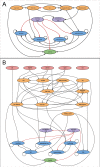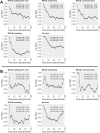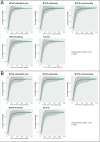Predicting functional impairment trajectories in amyotrophic lateral sclerosis: a probabilistic, multifactorial model of disease progression
- PMID: 35266043
- PMCID: PMC9217910
- DOI: 10.1007/s00415-022-11022-0
Predicting functional impairment trajectories in amyotrophic lateral sclerosis: a probabilistic, multifactorial model of disease progression
Abstract
Objective: To employ Artificial Intelligence to model, predict and simulate the amyotrophic lateral sclerosis (ALS) progression over time in terms of variable interactions, functional impairments, and survival.
Methods: We employed demographic and clinical variables, including functional scores and the utilisation of support interventions, of 3940 ALS patients from four Italian and two Israeli registers to develop a new approach based on Dynamic Bayesian Networks (DBNs) that models the ALS evolution over time, in two distinct scenarios of variable availability. The method allows to simulate patients' disease trajectories and predict the probability of functional impairment and survival at different time points.
Results: DBNs explicitly represent the relationships between the variables and the pathways along which they influence the disease progression. Several notable inter-dependencies were identified and validated by comparison with literature. Moreover, the implemented tool allows the assessment of the effect of different markers on the disease course, reproducing the probabilistically expected clinical progressions. The tool shows high concordance in terms of predicted and real prognosis, assessed as time to functional impairments and survival (integral of the AU-ROC in the first 36 months between 0.80-0.93 and 0.84-0.89 for the two scenarios, respectively).
Conclusions: Provided only with measurements commonly collected during the first visit, our models can predict time to the loss of independence in walking, breathing, swallowing, communicating, and survival and it can be used to generate in silico patient cohorts with specific characteristics. Our tool provides a comprehensive framework to support physicians in treatment planning and clinical decision-making.
Keywords: Amyotrophic lateral sclerosis; Artificial intelligence; Clinical trajectories; Dynamic Bayesian Networks; Population model; Prognosis modelling.
© 2022. The Author(s).
Conflict of interest statement
Dr. Chiò reports personal fees from Biogen, personal fees from Amylyx, personal fees from Denali, outside the submitted work. Dr. Di Camillo reports grants from The Italian Ministry of Foreign Affairs and International Cooperation, grants from the Ministry of Science, Technology and Space of the State of Israel, during the conduct of the study; grants from Italian Ministry of Health (Ministero della Salute), outside the submitted work. Dr. Drory reports grants from the Israel Ministry of Science, Technology and Space, during the conduct of the study. Dr. Grisan reports grants from The Italian Ministry of Foreign Affairs and International Cooperation, grants from the Ministry of Science, Technology and Space of the State of Israel, during the conduct of the study; personal fees from GE Healthcare, grants from Italian Ministry of Education, University and Research—PRIN, grants from Ministry of Health—Applied Research, outside the submitted work. Dr. Lunetta reports personal fees from Italfarmaco, personal fees from Mitsubishi Tanabe Pharma Europe, personal fees from Cytokinetics, outside the submitted work. Dr. Mandrioli reports grants from Emilia Romagna Regional Health Authority, during the conduct of the study. Dr. Beatrice Nafussy reports grants from the Ministry of Science, Technology and Space of the State of Israel during the conduct of the study. Dr. Zandonà reports grants from The Italian Ministry of Foreign Affairs and International Cooperation, grants from the Ministry of Science, Technology and Space of the State of Israel, during the conduct of the study. The tool presented in this paper was patented on 22 July 2020 as PCT/IT2020/000057: “Method for determining the prognosis of disease progression and survival for patients affected by Amyotrophic Lateral Sclerosis”, Di Camillo B, Zandonà A, Daberdaku S, Tavazzi E, Chiò A, Vasta R, Calvo A, Moglia C, Casale F, D’Ovidio F, Mandrioli J, Lunetta C, Drory V, Mora G, and Gotkine M. No other competing interests declared.
Figures





References
MeSH terms
Grants and funding
- ERRALS register grant/Regione Emilia-Romagna
- 259867/Seventh Framework Programme
- "Departments of Excellence" (Law 232/2016)/Ministero dell'Istruzione, dell'Università e della Ricerca
- PRIN, grant 2017SNW5MB/Ministero dell'Istruzione, dell'Università e della Ricerca
- CompALS project/Ministero degli Affari Esteri e della Cooperazione Internazionale
LinkOut - more resources
Full Text Sources
Medical
Miscellaneous

